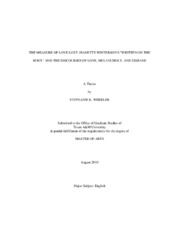| dc.description.abstract | Jeanette Winterson’s novel Written on the Body asks what it means to express love not through language but through the body, where it is felt, challenging the boundaries placed between body and language. Using Winterson’s novel and Roland Barthes’s A Lover’s Discourse as points of inquiry, this thesis examines conceptions of love based on heteronormative and romanticized visions of present and healthy bodies. This thesis asks how a body that is diseased and dying can express an emotion that is predicated on these very notions of presence, absence, and health.
The narrator of the novel sees love as a scripted story that, once adhered to, determines the (successful) experience of love. Louise’s cancer threatens these scripts of love, as it destroys the narrator’s conception of both love and Louise. Despite the fact that Louise is absent and dying, the narrator begins to write a new story that will allow him/her to have a perfect relationship with Louise, so that s/he can reconcile the contradictions of the scripts that the relationship exposed. Using Slavoj Zizek’s “Melancholy and the Act” and Richard Stamelman’s Lost Beyond Telling as frameworks of mourning and melancholy, the narrator’s melancholy over a lost presence thus emerges as a way that allows him/her to create a perfect love story. To make Louise appear perfect in this perfect love story, the narrator manipulates the language of disease that reconstructs Louise's physical absence as a textual presence. The discourse surrounding Louise thus begins to operate out of the desire to compensate and supplement what is missing; in Louise's case, the narrator is supplementing her with a "normal," healthy body.
Looking in the shadows of the narrator’s memories, Written on the Body emerges as not only an account of the narrator’s love story, but also an account of Louise’s story, a story of a body that refuses to be written on and demands to be heard. Winterson demonstrates how the body is always in the process of creating knowledge and meaning that can only be obtained by questioning what is normal, both for the body and for the scripts we all adhere to. | en |


